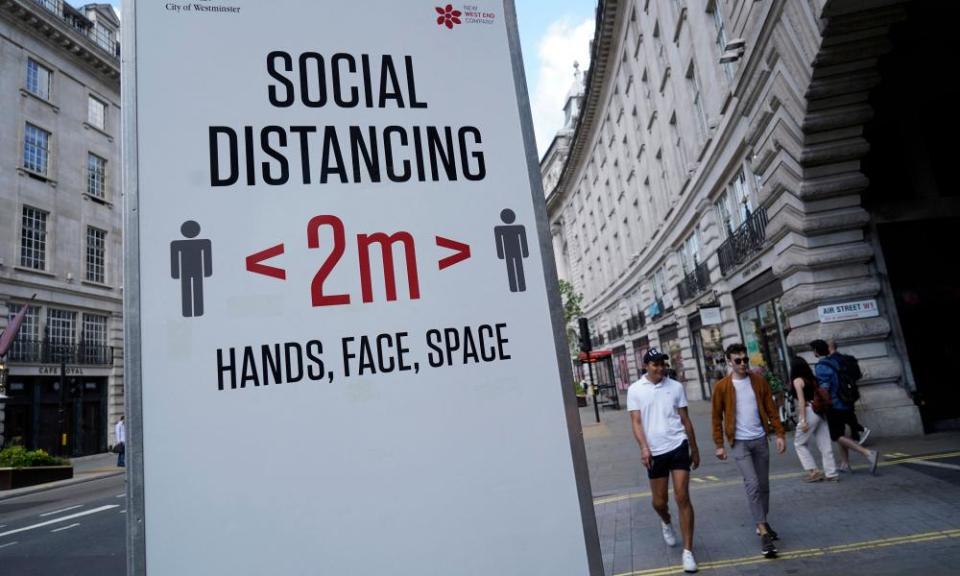How do we learn to live with Covid in the UK?

The Commons vote to delay step four of England’s roadmap out of lockdown has focused attention on when and how the country can draw a line under social distancing and, in the words of the prime minister, “learn to live with the virus”.
While the surge in cases in Blackburn – one of the original Delta variant hotspots – may have peaked for now, Public Health England expects recent rises in the north-west to be mirrored across the UK. What that means for hospitals and lives will become clearer in the next four weeks.
Whatever the epidemic does, the overwhelming view among senior scientists is that coronavirus is here to stay. The cold assessments came from the left and right of Boris Johnson at Monday’s Downing street briefing. From one side, Sir Patrick Vallance, the chief scientific adviser, said the virus “will be with us forever”. From the other, Prof Chris Whitty, England’s chief medical officer, warned of Covid illness and deaths “for the rest of our lives.”
But what does it mean to live with coronavirus? Siân Griffiths, emeritus professor at the Chinese University of Hong Kong, who co-chaired the 2003 Sars inquiry for the Hong Kong government, said it called for a new balance between knowing the virus was around and needed to be dealt with, and the knowledge that we needed to get back to a life that was not focused on the virus.
“I don’t think we’ll live in a restricted society. We’ll move into a more careful society, a more cautious society and one where we understand the science and the process and we have learned from the traumas of the pandemic,” she said.
Prof Dame Anne Johnson, president of the Academy of Medical Sciences, said: “There will be more deaths from coronavirus, with winter waves a particular threat, but learning to live with Covid is not about how many deaths society can bear. We see upsurges caused by respiratory viruses every winter. We don’t make an estimate of what deaths we can tolerate, we say we wish to minimise those deaths by having a vaccination campaign.”
Johnson said that we will not wake up one day and suddenly decide to face the virus. The process has already begun, with changes in behaviour adopted in the pandemic likely to carry on long after formal restrictions are lifted. “What we want is to do the things that least disrupt our lives and minimise the risk of infection without having to go into these awful lockdowns,” she said. Good hygiene, remote working, mask wearing, better ventilation, not going to work or mixing with people when we have symptoms, cycling rather than taking public transport, avoiding needless flights – all of these and more will play a part in the post-lockdown world, she said.
The vaccination programme is central to when life can return, if not to normal, then something far closer than today. By the autumn, most adults will have had the chance to get two shots of vaccine. “Once everybody who is eligible is vaccinated then you have put your wall in place, but we are not there yet,” said Griffiths. “The wall is missing some bricks, in terms of some vulnerable groups, some vaccine sceptics, but mainly the younger people, and until your wall is there you can’t say let’s move forward.” Seasonal boosters for at-risk groups are likely if their immunity wanes, and ongoing natural infections will contribute to community immunity.
What else needs to happen? David Heymann, professor of infectious disease epidemiology at the London School of Hygiene & Tropical Medicine and head of the Centre on Global Health Security at Chatham House, said we would not learn to live with the virus until we took responsibility for the risks, as we do with the flu, sexually transmitted infections and other viruses. “The first thing we have to do, is governments have to be willing and able to transfer the risk assessment and the response to the people instead of doing it through the people.
“It’s not a matter of saying we’ll accept this number of deaths, we should never accept deaths. We need to learn how we ourselves can make sure we don’t infect ourselves or infect others, but that’s just not been possible yet because governments have done that job,” he said.
Heymann said that transferring the responsibility for keeping ourselves and others safe should have started earlierd. “There was a golden opportunity before Christmas to tell people, if you might get in a situation where you could be infected – say, at a closed, indoors party with people drinking – you should remember you could infect family members and should take proper precautions if you’re visiting them. That messaging is extremely important now because people have to assume responsibility,” he said.
George Davey Smith, professor of clinical epidemiology at the University of Bristol, said people would first need to be convinced that vaccines were having a major impact on the risk of severe disease. “There is a job to do in reducing people’s fear levels. It’s going to be a gradual thing.”
Griffiths said the hope was to get coronavirus under the same level of control as influenza. In a typical year, influenza still kills thousands of people in the UK, but deaths are minimised by a vaccination campaign that targets the most vulnerable and is crucially informed by a global flu surveillance network. A similar surveillance system is needed for coronavirus, and ultimately, other pandemic threats. “Just as we live with flu in the winter season, we’ll live with Covid alongside,” she said.

 Yahoo Movies
Yahoo Movies 